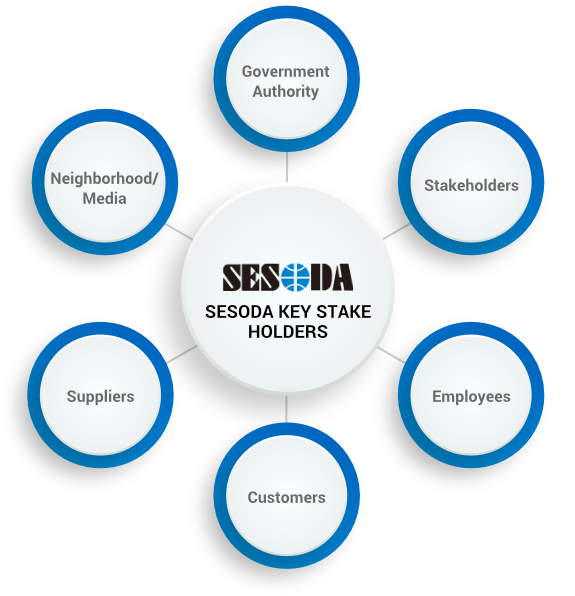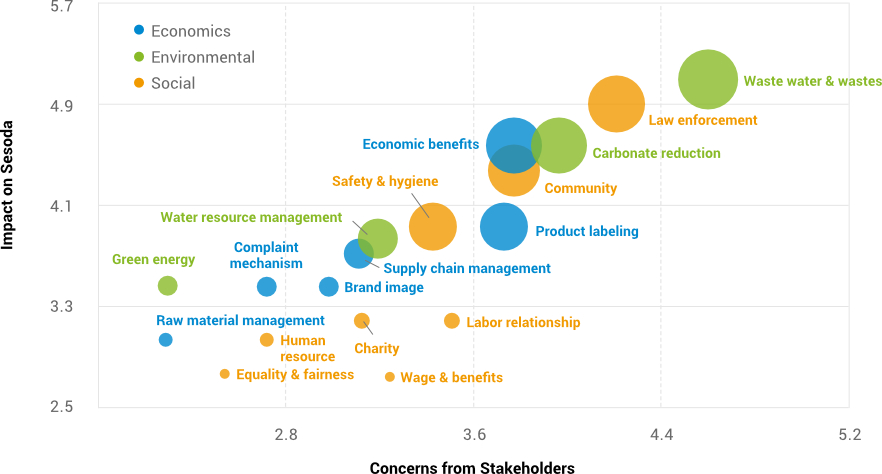
Corporation Social Responsibility
Fulfill carbon reduction, build green homes, emphasize environmental education
Major theme identification process
Distinguish key stakeholders
6 categories
Collect key stakeholders focal items and integrate into sustainable topics
18 items
“Degree of Stakeholders interest” and “Drgree of impact effect on SESODA”
Critical Subjects
8 items
Specific stubjects per GRI rules
9 items
Stakeholder Identification
Stakeholders influence Sesoda itself or groups affected by Sesoda, in order to communicate with stakeholders in a timely manner, control the sustainability issues that stakeholders care about us, and integrate them into Sesoda's sustainable development strategy, and establish a smooth relationship with stakeholders. We use an open and transparent attitude to communicate with stakeholders in accordance with the GRI Standards of Sustainable Reporting. The process includes exposing the types of major stakeholders, communication channels, and information about major stakeholders.
First of all, Sesoda convened the CSR meeting of the year to identify the main stakeholders and list the sustainability issues that the main stakeholders are concerned about, based on this as a reference basis for the disclosure of the report. In 2018, six types of major stakeholders were identified, namely, government agencies, shareholders, employees, customers, suppliers, and community neighborhoods/media.

Communication with Main Stakeholders
Sesoda aims at the main stakeholders and obtains the sustainability issues that are of concern to all stakeholders through routine diversified channels. After discussion and screening at the CSR meeting, the list is compiled into a list of sustainability issues, through routine communication channels and stakeholders The related parties conduct communication and dialogue to understand their needs and expectations for Sesoda, and serve as a reference for Sesoda's sustainable management.
| Main Stakeholders | Communication/Channels | Concerned Subjects | Sesoda's Response |
|---|---|---|---|
| Government agencies |
|
Legal compliance with corporate governance Ethical integrity risk management Energy management Water management Greenhouse gas emissions Labor-management relations Waste water and waste Occupational safety and health |
Sesoda is based on the spirit of taking everything from society and using it in society. It strives to implement environmental protection measures, improve the surrounding environment of the factory, and strive to comply with government laws and regulations such as environmental protection and industrial safety. Sesoda expects its efforts to be recognized by the society and actively strives for the community approval. |
| Shareholder |
|
Economic performance compliance Corporate Governance Sustainable Management Risk management ethical integrity Brand |
In response to the instability of the international economic development and the drastic fluctuations in energy prices, Sesoda's senior executives formulate sustainable business strategies, carry out various risk management and control, evaluate research and development of new products and develop product markets, so that Sesoda can continue to make steady profits with the highest commitment to shareholders. |
| Employee |
|
Economic performance Salary and benefits Talent cultivation grievance mechanism Communication between labor and management, occupational safety and health |
Employees are Sesoda's greatest wealth. In addition to establishing a labor union to protect employees' rights, we also coordinate with the company's business planning and development goals to implement education and training for employees on various functions from time to time. In terms of employee benefits, Sesoda is also superior to the level of traditional industries. |
| Client |
|
Economic performance Brand image Sustainable management, ethical integrity Product quality customer satisfaction After-sales service |
With the belief of creating a win-win situation, Sesoda maintains customer trust in us, improves customer satisfaction, and creates brand value. |
| Supplier |
|
Economic performance and sustainable operation Ethical integrity, product quality Waste water and waste supply chain management |
With the belief in creating a win-win situation, Sesoda maintains a cooperative relationship of mutual trust and mutual benefit with domestic and foreign suppliers. In addition to attaching importance to the stable supply of raw materials, Sesoda also values the performance of suppliers in the environment, labor and human rights, and occupational safety, and works together to fulfill social corporate responsibilities. |
| Community/Media |
|
Ethical integrity and energy saving Waste water and waste Carbon emission energy Greenhouse gas emissions Maintenance of community relations |
Sesoda is committed to coexisting harmoniously with the communities and neighborhoods around the plant. In addition to creating local economic performance, it also participates in community activities in different ways. |
Major theme identification
First, Sesoda is based on the principle of stakeholder inclusiveness, which is the principle of defining report content: Sesoda has identified the main stakeholders; according to the principle of sustainability: it reveals how Sesoda has an impact on local, regional and global economic, environmental and social conditions , Development and trends to improve or reduce damage; according to the principle of materiality: reflect significant economic, environmental and social impacts and will materially affect the evaluation and decision-making of stakeholders; according to the principle of completeness: the major themes contained in the report and their boundaries This is sufficient to reflect the significant economic, environmental and social impact of Sesoda, and enable stakeholders to evaluate Sesoda's performance during the reporting period.
Second, the accuracy of the report quality principle is defined by Sesoda: the information in the report is sufficiently accurate and detailed for stakeholders to evaluate Sesoda's performance; balance: the information in the report reflects the positive and negative performance of Sesoda, so that all walks of life can make a reasonable assessment of overall performance; clarity: Sesoda presents information in a way that can be easily understood and obtained by stakeholders who use the information; comparability: Sesoda uses consistent standards to screen, sort and report information. The way of information expression allows stakeholders to analyze long-term performance and compare and analyze with other peers; Reliability: The information and processes used by Sesoda in preparing the report are available for review and can establish information quality and Significant ways to collect, record, aggregate, analyze and expose, and timeliness: Sesoda reports regularly and provides timely information for stakeholders to make decisions. The spirit of the six principles is injected into this report.

Identify 4 key principles
Key stakeholders and inclusiveness, Trace of sustainability, Critality, Completeness
Identify 6 quality principles of report
Accuracy, Balance, Clarity comparability, Reliability, Timeliness
Complete CSR reports
Finally, Sesoda takes the sustainability issues of the latest edition of the GRI Standards released by the Global Sustainability Reporting Association (GRI) as the foundation, and refers to the issues of concern to major stakeholders, including corporate governance, economics, environment, and from the social and other aspects, after discussion and selection at the Sesoda's CSR meeting, 18 sustainability issues were listed, including 3 economic aspects, 6 environmental aspects, and 9 social aspects. Then, according to the “stakeholders' concern” and “right Sesoda's impact degree” was created into a matrix of major themes, and 8 major themes of Sesoda this year were identified, namely: economic performance, compliance with laws and regulations, carbon reduction, water resources management, waste water and waste, occupational safety and health, and community Relationship maintenance and product labeling, Sesoda will disclose the management methods and performance data of major topics in this report.
| Facing | Sustainable issues |
|---|---|
| Economic | Economic performance, compliance with laws and regulations, appeal mechanism |
| Environment | Supply chain management, raw material management, green energy, carbon reduction, water resources management, waste water and waste |
| Society | Labor-management communication, salary and welfare, occupational safety and health, talent cultivation, employee equality and non-discrimination, maintenance of community relations, product labeling, brand image, participation in public welfare activities |
Note: Corporate governance, ethical integrity, and risk management are necessary disclosure items required by the GRI Standards, so they are no longer included in the list of sustainability issues.
The Matrix of Major Themes

Comparing the major themes identified in 2017 and 2018, economic performance and environmental protection (including waste water and waste, water resources management, and carbon reduction) remain among the major themes. In 2018, new laws and regulations, occupational safety and health, and community relations have been added. Major themes such as maintenance and product labeling show that Sesoda has expanded its scope in fulfilling corporate social responsibilities, and at the same time, it strengthens the interaction with the neighboring communities in the factory area and strives for social recognition. As for the major themes identified in 2017, such as corporate integrity and risk control, as they are required to be disclosed in the GRI Standards, this report will still disclose relevant content.
Internal and external boundaries of major topics
According to the scope of the impact that may occur inside or outside Sesoda, the boundaries for identifying major themes in 2020 are as follows:
| Major theme | Inner boundary | Outer boundary | GRI Standards General Disclosure (Specific subject indicators) | Corresponding to Article 4 of the "Methods for the Preparation and Application of Corporate Social Responsibility Reports by Listed Companies", the chemical industry should disclose the content | Chapter Revealed in the Report | ||||
|---|---|---|---|---|---|---|---|---|---|
| Sesoda | Government Agencies | Shareholders | Suppliers | Client | Community/Media | ||||
| Economic performance |
|
|
|
|
|
|
Economic performance(201-1) |
N/A |
3.6Economic performance |
| Compliance |
|
|
|
|
|
|
Environmental compliance (307-1) Socioeconomic compliance (419-1) |
N/A |
3.5Compliance |
| Carbon reduction |
|
|
|
|
|
|
Greenhouse gas emissions (305-1, 2) | Operational activities that have a significant actual or potential negative impact on the local community. | 4.4Greenhouse gas management |
| Water resources management |
|
|
|
|
|
|
Water sources significantly affected by water intake (303-2) | Operational activities that have a significant actual or potential negative impact on the local community. | 4.2Water resources management |
| Waste water and waste |
|
|
|
|
|
|
Waste transportation (306-4) Local community (413-2) |
|
4.3Waste management 5.2Social participation |
| Occupational safety and health |
|
|
|
|
|
|
Occupational safety and health(403-2) | Indicate the types of injuries suffered by employees, and calculate the injury rate, occupational disease rate, lost work days rate, absenteeism rate, and number of work-related deaths. | 5.1Occupational safety and health |
| Community relationship maintenance |
|
|
|
|
|
|
Local community(413-2) |
|
5.2Social participation |
| Product label |
|
|
|
|
|
|
Marketing and labeling (417-1) |
N/A |
5.4Product Liability |




